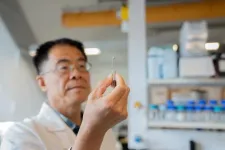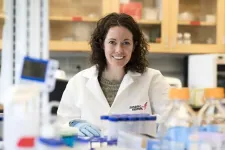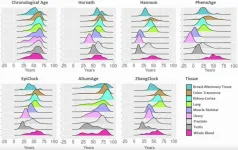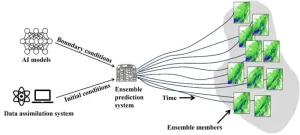(Press-News.org) Recognition of telehealth as an effective strategy for delivering treatment for substance use disorder (SUD) has raised hopes for improving access to this treatment in settings with limited transportation or when time constraints compromise regular use of consistent access to in-person substance use treatment.
But the findings from a team of researchers from the Virginia Center for Health Innovation, UCLA, RAND, and MedInsight, Milliman Inc., suggest that the promise of telehealth may vary by insurance and geography.
New research suggests that people who live in rural areas may be benefiting from telehealth as a modality for substance use disorder treatment to a greater extent than their urban counterparts. Meanwhile, despite accounting for the vast majority of substance use disorder services, people covered by Medicaid managed care are less likely to use telehealth compared with their counterparts who have Medicare Advantage or are commercially insured.
“We found diminishing rates of access to telehealth substance use disorder treatments among Medicaid managed care recipients, who are largely lower-income or socioeconomically disadvantaged,” Dr. Lauryn Walker, Chief Strategy Officer at the Virginia Center for Health Innovation and the study’s lead author. “In contrast, telehealth use appears to be closing previously reported gaps in substance use disorder treatment among rural individuals compared with those in urban settings.”
The findings are described in a research letter to be published Feb. 12 in the peer-reviewed JAMA Network Open.
As telehealth became more popular as a treatment modality, with the hope of expanding access to care, Medicaid managed care beneficiaries received fewer SUD services overall while commercial and Medicare Advantage beneficiaries experienced an increase in service utilization during the same time period. Rural individuals experienced the greatest overall increase in substance use disorder treatment among all populations studied.
The researchers used the MedInsight Emerging Experience database to examine Medicaid managed care, Medicare Advantage, and commercial insurance claims for all 50 states for about 16 million adults age 18 years and older who were insured for 12 or more months between Jan. 1, 2019 and June 30, 2023.
Key findings include:
Monthly telehealth substance use treatment increased substantially from 45to 10,974services, while in-person treatment increased much less notably from 186,000 to 292,300 services between 2019 and 2023
Despite the addition of telehealth as a modality of care, average monthly substance use disorder treatment services per 100,000 adults (telehealth and in-person combined) decreased 17% for Medicaid covered individuals while they increased for Medicare Advantage and commercial insurance beneficiaries by 4% and 1%, respectively
With Medicaid-covered individuals accounting for 93% of overall SUD treatment and in-person services, but only 75% of telehealth utilization, telehealth use is notably under-represented among those insured by Medicaid. Commercial and MA members, on the other hand, disproportionately use telehealth, accounting for only 5.8% and 0.4% of in-person SUD services respectively, yet 24.0% and 1.0% of telehealth services respectively.
Rural individuals experienced an 90% increase in overall substance use treatment per 100,000 adults between 2019 and 2023, while rising 49% among urban individuals.
Telehealth may be contributing to the overall increased utilization for rural individuals, with 8% of telehealth services provided to rural individuals compared to 6% of overall and in-person substance use disorder treatment services.
Federal policymakers continue to evolve telehealth and in-person requirements for SUDT. Research on how various populations use telehealth for their substance use disorder treatment can inform future effective policies to improve care for all populations.
“Telehealth is a relatively new modality of care, and policies and procedures are evolving quickly,” said Dr. Katherine Kahn, Distinguished Professor of Medicine in the division of general internal medicine and health services research at the David Geffen School of Medicine at UCLA and the study’s senior author “Understanding who is, and importantly, who is not using telehealth is essential for creating policies that promote access to care and minimize unintended consequences of reductions in care.”
There are some limitations to the study. Organizations voluntarily contribute claims to the database, potentially limiting generalizability. However, the database reflects payer coverage consistent with U.S. demographics.. Also, the findings do not include uninsured individuals as well as providers that do not accept insurance.
Study co-authors are Manying Cui and Dr. John Mafi of UCLA, Jonathan Cantor and Cheryl Damberg of RAND, and Melody Craff of MedInsight, Milliman Inc. Kahn and Mafi are also affiliated with RAND.
END
Telehealth may be closing the care gap for people with substance use disorder in rural areas
2025-02-12
ELSE PRESS RELEASES FROM THIS DATE:
Stronger, safer, smarter: pioneering Zinc-based dissolvable implants for bone repair
2025-02-12
Monash research could transform how broken bones are treated, with the development of a special zinc-based dissolvable material that could replace the metal plates and screws typically used to hold fractured bones together.
Surgeons routinely use stainless steel or titanium, which stay in the body forever, can cause discomfort and may require follow-up surgeries. A new zinc alloy, designed by Monash biomedical engineers, could solve these problems by being mechanically strong but gentle enough to degrade safely over time while supporting optimal healing.
A study published today in Nature shows the research team’s innovative ...
Could peripheral neuropathy be stopped before it starts?
2025-02-12
An increase in high-fat, high-fructose foods in people’s diets has contributed to a dramatic increase in type 2 diabetes. This, in turn, has led to an increase in peripheral neuropathy — nerve damage, typically in the hands and feet — that causes weakness, loss of sensation and, in some, a stabbing, burning, or tingling pain. About half of people with type 2 diabetes are affected, and of these, about half experience severe neuropathic pain.
The damage begins as axons from sensory neurons begin to retract and disappear from the tissues they innervate. New research from the lab of Clifford Woolf, MB, BCh, PhD, director ...
China Jurassic fossil discovery sheds light on bird origin
2025-02-12
A research team led by Professor WANG Min from the Institute of Vertebrate Paleontology and Paleoanthropology (IVPP) of the Chinese Academy of Sciences has discovered two bird fossils in Jurassic-era rocks from Fujian Province in southeast China. These rocks date back approximately 149 million years. The fossils fill a spatiotemporal gap in the early evolutionary history of birds and provide the evidence yet that birds were diversified by the end of the Jurassic period.
This study was published in Nature.
Birds ...
Long-term yogurt consumption tied to decreased incidence of certain types of colorectal cancer
2025-02-12
Yogurt, which contains live strains of bacteria, is thought to protect against many types of diseases, with some reports indicating it could reduce risk of colorectal cancer. A new study led by investigators from Mass General Brigham finds that yogurt consumption over time may protect against colorectal cancer through changes in the gut microbiome. Using data from studies that have followed participants for decades, researchers found that long-term consumption of two or more servings per week of yogurt was tied to lower rates of proximal colorectal cancer positive ...
Ovarian cancer discovery could turn failed treatment into lifesaver
2025-02-12
University of Virginia Cancer Center researchers have explained the failure of immune checkpoint therapy for ovarian cancer by discovering how gut bacteria interfere with the treatment. Doctors may be able to use the findings to overcome this treatment failure and save the lives of thousands of women every year.
The new discovery, from the lab of UVA’s Melanie Rutkowski, PhD, speaks to the surprising ways that the microbiome – the collection of organisms that live on and inside our bodies – is vital not only to ...
DNA methylation clocks may require tissue-specific adjustments for accurate aging estimates
2025-02-12
“Our results suggest that forensic applications of DNAm clocks using non-blood tissue types will provide age estimates that are not as accurate as predictions based on blood, especially if using clocks algorithms trained on blood samples.”
BUFFALO, NY—February 12, 2025 — A new research paper was published in Aging (Aging-US) on January 3, 2025, in Volume 17, Issue 1, titled “Characterization of DNA methylation clock algorithms applied to diverse tissue types.”
Researchers ...
Tidal energy measurements help SwRI scientists understand Titan’s composition, orbital history
2025-02-12
SAN ANTONIO — February 12, 2025 —Southwest Research Institute (SwRI) scientists are studying Saturn’s moon Titan to assess its tidal dissipation rate, the energy lost as it orbits the ringed planet with its massive gravitational force. Understanding tidal dissipation helps scientists infer many other things about Titan, such as the makeup of its inner core and its orbital history.
“When most people think of tides they think of the movement of the oceans, in and out, with the passage of the Moon overhead, said Dr. Brynna Downey. “But that is just because water moves ...
Data-driven networks influence convective-scale ensemble weather forecasts
2025-02-12
To effectively present the uncertainty of convective-scale weather forecasts, convective-scale ensemble prediction systems have been developed at major operational centers, whose lateral boundary conditions are usually provided by global numerical weather models. Recently, the emergence of AI weather models has provided a new approach to driving convective-scale ensemble prediction systems. AI weather models can produce forecasts for the next 7 to 10 days in just a few minutes, which is around 10,000 times faster than numerical weather models. However, the performance of using the ...
Endocrine Society awards Baxter Prize to innovator in endocrine cancer drug discovery
2025-02-12
WASHINGTON—Donald Patrick McDonnell, Ph.D., has been awarded the Endocrine Society’s John D. Baxter Prize for Entrepreneurship for discovering hormone therapies for treating breast and prostate cancer, the Society announced today.
The John D. Baxter Prize for Entrepreneurship was established to recognize the extraordinary achievement of bringing an idea, product, service, or process to market. This work ultimately elevates the field of endocrinology and positively impacts the health of patients.
McDonnell is a professor at Duke University School ...
Companies quietly switching out toxic product ingredients in response to California law
2025-02-12
A new study by Silent Spring Institute and University of California, Berkeley shows how laws that promote greater transparency around harmful chemicals in products can shift markets toward safer products.
The study, published in the journal Environmental Science & Technology, focused on California’s right-to-know law called Proposition 65, or Prop 65. Under the law, the state of California maintains a list of approximately 900 chemicals known to cause cancer, birth defects, or reproductive harm. Companies that sell products in California are required to warn people if their products could expose them to harmful ...





